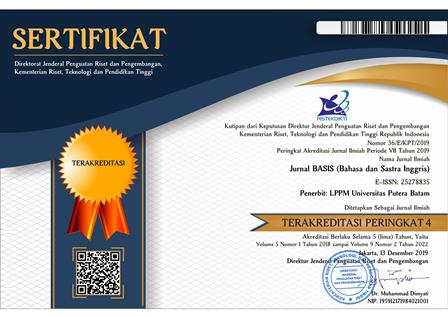ILLOCUTIONARY ACTS ON PRESIDENT OBAMA’S ELECTION NIGHT SPEECH
DOI:
https://doi.org/10.33884/basisupb.v6i2.1416Kata Kunci:
illocutionary acts, speech acts, types of illocutionary acts.Abstrak
The research design of this study is descriptive qualitative. The data sources of this research are “Transcript of President Obama’s Election Night Speech” which is taken from the internet. The transcript is written by Federal News Service. This paper merely focuses on analyzing the most dominant types of Speech Actss on Transcript of President Obama’s Election Night Speech. This Transcript File of Federal News Service is analyzed by the perspective of Searl’s theory. From the analysis of audio file entitled “Transcript of President Obama’s Election Night Speech” it can be found four types of Searle’s illocutionary actss: Directive, commisive, representative and expressive. There are 33 data of illocutionary actss which consist of : 3 data are the type of Directive: 3 data showing request, 12 data of the type of Commisive: ten data is showing a promising and 2 data showing offering,11 data of the type of Representative: 7 data showing of asserting, 1data showing of concluding, and 1 data showing describing. 8 data of the type of Expressive: 7 data showing the thanking and 1 data showing apologizing. From the classification of the data, it can be seen clearly that the type of commisive is the most dominant. This was used since the President as a speaker want to declare the promising about future America during the reign in front of American people.
Referensi
Bayat, N. (2013). A Study on the use of Speech Actss. Procedia - Social and Behavioral Sciences, 70, 213–221. https://doi.org/10.1016/j.sbspro.2013.01.057
Marquez Reiter, R. (2002). Linguistic politeness in Britian and Uruguay; A contrastive study of requests and apologies. Philadelphia: John Benjamins Publishing Company.
Mubarak, Z. H. (2019). the Analysis of Repetition As Part of Lexical Cohesion in Talk Shows. Jurnal Basis, 6(1), 81. https://doi.org/10.33884/basisupb.v6i1.1040
Nordquist Richard. (2019). Speech-acts theory. Retrieved October 1, 2019, from https://www.thoughtco.com/speech-acts-theory-1691986
Searle, J. (2005). Expression and meaning: Studies in the theory of Speech Actss. Cambridge University Press.
Simon, S., & Dejica-Cartis, D. (2015). Speech Actss in Written Advertisements: Identification, Classification and Analysis. Procedia - Social and Behavioral Sciences, 192, 234–239. https://doi.org/10.1016/j.sbspro.2015.06.033
Transcript of President Obama’s Election Night Speech. (2012). 7 November. Retrieved from https://nyti.ms/2k4ATuS
Yule, G. (1996). Pragmatics. OUP Oxford, 1996.
##submission.downloads##
Diterbitkan
Terbitan
Bagian
Lisensi

















